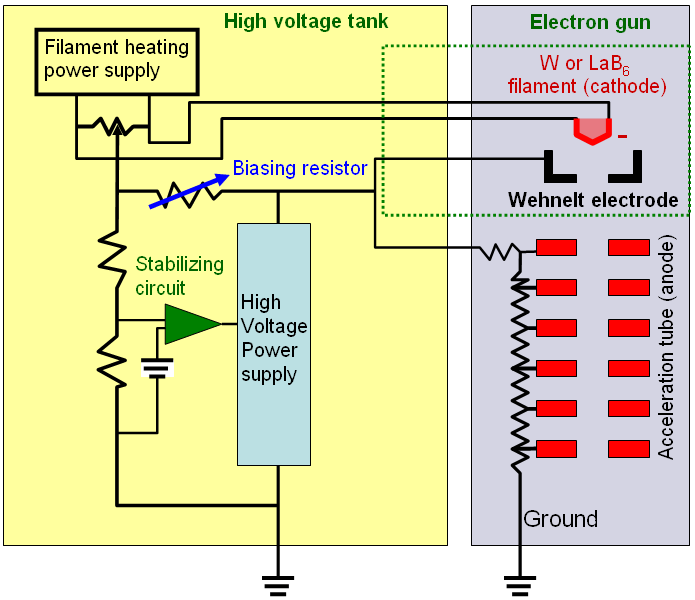|
This book (Practical Electron Microscopy and Database) is a reference for TEM and SEM students, operators, engineers, technicians, managers, and researchers.
|
=================================================================================
Tungsten can be used in both thermionic electron guns and field-emission (CFE) electron guns.
In conventional electron microscopes (EM), an electrically heated tungsten (W) filament, at a negative potential 20 - 200 kV, is mounted on a ceramic insulator behind a Wehnelt cap with a central hole. The electrons emitted from the filament are accelerated and focused, via a double condenser lens system with field-limiting apertures, onto the EM specimen.
Before the application of field emission electron guns in TEM, the energy resolution of EELS systems had been ~1–2 eV, mainly limited by the energy spreading of thermionic electron source (tungsten or LaB6 filaments). In the late 1990s, Schottky emission sources became available and have been providing energy resolution greater than 0.5 eV. Note that LaB6 and W (tungsten) electron guns normally provides incoherent electron rays. Figure 3931 shows the schematic illustration of the electric circuit of thermionic electron guns with tungsten and LaB6 filaments. The main part which is different from thermal FEG is dash-green-boxed.

Figure 3931. Schematic illustration of the electric circuit of thermionic electron guns with tungsten and LaB6 filaments. In EMs, the condenser aperture is used to exclude electrons emitted at high angles from the electron gun, which will decrease the brightness but improve the quality of the illumination because these peripheral electrons are less coherent, especially in LaB6 and W (tungsten) guns. A table on the comparison of various electron sources in page1409 indicates that the LaB6 guns should be used under a higher vacuum than the tungsten guns, and the LaB6 guns provide higher brightness, smaller electron source, and smaller energy spread. Therefore, the LaB6 guns are more suitable for analytical electron microscopes than the tungsten guns.
Field-emission sources normally consist of pointed tungsten wires (filament emitters) exposed to a high electric field. It is called a “field emission” gun because the electric field causes high-energy electrons to be emitted from a filament emitter. In the case of heated FEGs (Schottky emitters), the tip of the wire is coated with ZrO2 (zirconium oxide) to raise electrical conductivity. Cold field-emission (CFE) gun emitter is normally made of tungsten with the surface of the (310) plane, working at room temperature without heating. Contamination of residual gases on the surface of the emitter generates emission noise. For the same reason, the cold emission guns are not very stable. For instance, some emission current from a freshly cleaned tip only takes 40 min to decay to 50%. [1] Therefore, regular maintenance, the so-called flashing process, is often needed.
[1] Krivanek OL, Corbin GJ, Dellby N, Elston BF, Keyse RJ, Murfitt MF, Own CS, Szilagyi ZS, Woodruff JW. An electron microscope for the aberration-corrected era, Ultramicroscopy, 108 (2008) 179–195.
|
